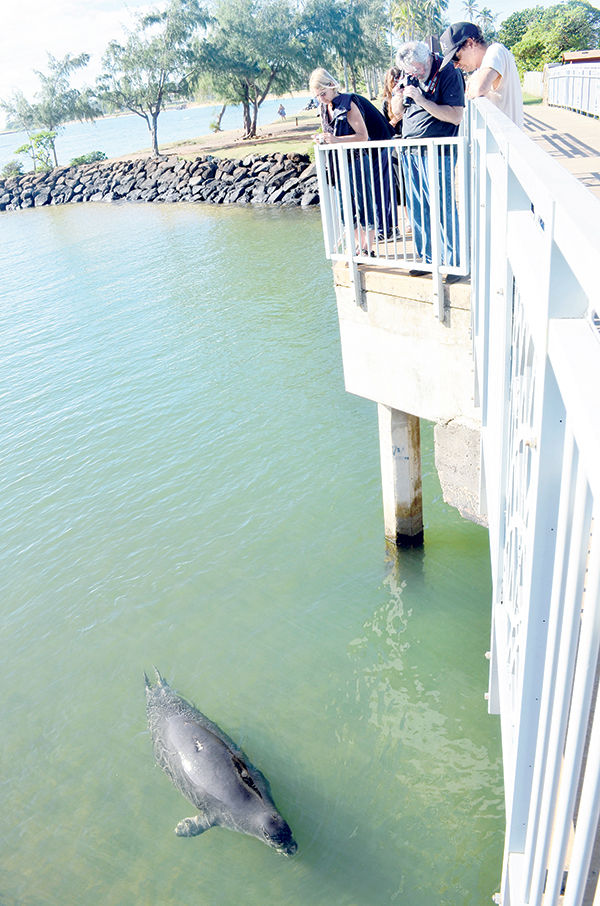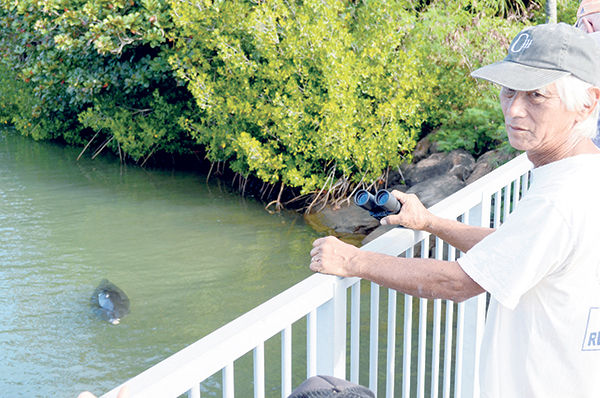KAPAA — Is she alive? Do they come up the canal often? Do you know which monk seal this is? Those are the types of questions Lloyd Miyashiro fields on a daily basis in his capacity as a volunteer with
KAPAA — Is she alive? Do they come up the canal often? Do you know which monk seal this is?
Those are the types of questions Lloyd Miyashiro fields on a daily basis in his capacity as a volunteer with the Kauai Monk Seal Conservation Hui.
In this particular case, the answer to all three is “yes.” And Miyashiro is more than happy to share information.
On Friday morning, Miyashiro, who along with his wife Mary leads a team of volunteers on the island’s Eastside, received a call that K-13, a female Hawaiian monk seal in her mid-teens, was swimming in the canal at the north end of Kapaa Beach Park.
It is nothing unusual for K-13. She frequents that spot. And when she turns up, be it here or a nearby stretch of sand, Lloyd, Mary or another volunteer responds to assess the situation, set up signs if appropriate and conduct public outreach.
On Friday, Miyashiro came armed with binoculars, photographs, including from when K-13 gave birth in 2012, an information sheet and, most importantly, knowledge to share with residents and tourists. Many people stopped to take pictures of the animal as it slowly cruised the brackish water, and Miyashiro was quick to offer his binoculars so people could get a closer look.
“She’s about the only one that does this in canals,” Lloyd tells passersby. “It’s her way of resting.”
K-13 can easily be identified, Miyashiro explains. She is blind in her left eye and has tooth-like scars near her left flipper from an encounter with a shark.
“Is she healthy?” one man stops and asks.
“For what she’s been through, yes,” Miyashiro responds. “She’s a survivor.”
The volunteer network on Kauai consists of 60 active volunteers working around the island. And the importance of their work cannot be stressed enough, according to Jamie Thomton, Kauai marine mammal response program coordinator for the National Oceanic and Atmospheric Administration.
“The volunteer network is truly the backbone of the marine mammal stranding program on Kauai,” Thomton said. “The level of dedication and commitment that this talented group displays on a daily basis, specifically with Hawaiian monk seals, is critical to the survival of this species.”
Anahola resident Kim Rogers found out about the network in early 2000 after a pup was born in Poipu. She remembers being amazed the average person like herself could get involved with protecting an endangered species.
Rogers signed up and has been helping ever since. Scouting remote beaches. Conducting health assessments. “Pup sitting,” a fun name for keeping an eye on baby monk seals. Even helping to tag newborn pups. It’s all been part of her work as a volunteer.
“It’s just amazing to me how much I get to do, and I’m not a scientist, I’m not a biologist,” she said.
Joanne Green and her husband Steve Goff of Olympia, Washington are annual visitors of Kauai. While they love all of the island’s attractions, monk seals — and the people working to protect them — are at the top of their list.
On Friday morning, on his way for coffee, Goff spotted the couple’s favorite Kauai seal, K-13, cruising up the canal. He called Joanne, who immediately called the Miyashiros. Within 15 minutes, Lloyd was there.
“It feels good to be part of it, even in a small way,” Joanne said. “I feel like I’m deputized.”
If Green and Goff lived on Kauai, the retired couple said they’d happily volunteer their time.
“It’s invaluable,” Green said when asked for her thoughts about the volunteer network.
Thomton said state and federal agencies can’t protect the endangered species all on their own. And as volunteers, people can be involved in a variety of ways, depending on their interest.
There are seal haul-out responders, those who arrive on the scene first when a seal comes onto a beach, assess the situation, set up signs and provide information to the public.
Public outreach and education volunteers are needed to share correct information about Hawaiian monk seals to various audiences on the beaches and in their communities. And there are also those who respond to marine mammal strandings, according to Thomton.
He said the network could easily use another 100 volunteers.
Rogers said most rewarding is being able to help, and potentially save, an endangered species. It’s an experience very few people get to have.
“We do have an opportunity to make sure that our actions, our human footprint if you will, doesn’t lead to their extinction,” she said.
In the case of Hawaiian monk seals, Rogers believes everyone — from the top scientists at NOAA to the person who phones the Kauai network to report a hauled out monk seal — can make a difference.
“It’s not about me,” she said of her reasons for getting involved. “It’s about what I can do to help the species.”
Those interested in volunteering with the Kauai Monk Seal Conservation Hui are asked to email kauaiseals@gmail.com or call 651-7668. Mimi Olry, Kauai Marine Mammal Response Program field coordinator with the state Department of Land and Natural Resources, will coordinate a time and location for new volunteer training. The initial training session takes place in the field, on a beach, and takes two hours.
•••
Chris D’Angelo, environment writer, can be reached at 245-0441 or cdangelo@thegardenisland.com.



